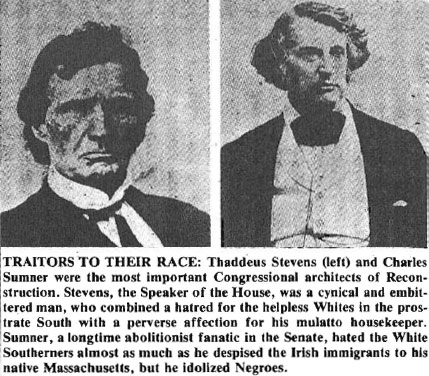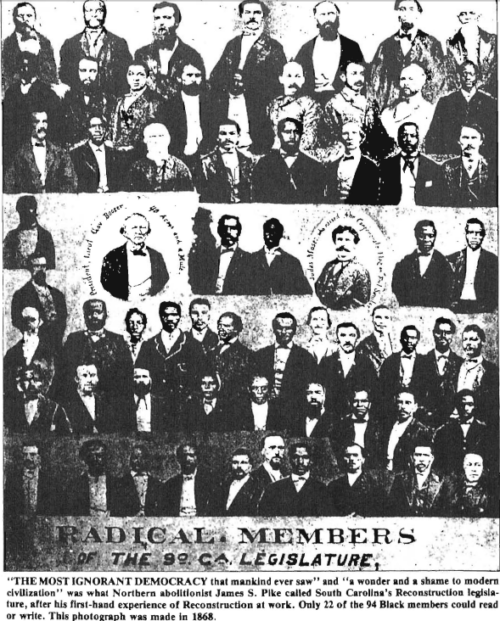The Shame of Reconstruction, part 1
by Ted O’Keefe
SHORTLY AFTER nightfall on September 8, 1865, a train steamed south from Orangeburg, South Carolina, through countryside which had been devastated by General William Sherman’s troops only a few months before. Among the passengers was a gaunt and battle-weary Confederate veteran named Calvin Crozier. After four years of war, Crozier was making the long journey home to face the grim task of rebuilding that awaited him in his native Galveston, Texas.
The former soldier had traveled alone until he reached Orangeburg, where a local doctor had asked him to escort two women journeying south to Georgia. Crozier readily agreed, for the collapse of the Confederate state governments had fostered anarchy throughout much of the South.
Outside Newberry the train came to a shuddering halt. It was no accident: the train had been deliberately derailed.
A large band of men milled around the train. Now two Blacks, obviously drunk, pushed their way into Crozier’s coach. They wore the blue uniform of the 33rd Regiment, U.S. Army. In the foulest language they could muster, they demanded that the White passengers present their purses and baggage for inspection for “rebel contraband.”
Calvin Crozier sprang to his feet and ordered the Blacks to leave the train. Their response was to elbow their way past the veteran and to begin pawing at the two women in his charge.
In a flash Crozier drew his knife and grappled with the Blacks in the darkened car. He slashed one of them across the face, and the two Blacks fled the train, screaming for help.
The Negro troops, enraged by this White resistance, forgot their search for booty. They forced the Whites from the train and seized a hostage, whom they proposed to shoot on the spot.
Calvin Crozier, who had been unrecognizable in the darkened coach, stepped forward. In level tones he told the Black soldiers that their business was with him, not the other man.
Without further ado the Blacks seized Crozier and led him away to the regimental bivouac, punctuating their whoops and threats with bayonet jabs and blows from their rifle butts. Crozier received no hearing. He was shot at the dawn of the next day. His killers mutilated his body. Then the Black soldiers cavorted drunkenly on his freshly filled grave, laughing and shouting.
The United States has defeated and laid waste no foreign nation as totally as it did the 11 states of the Confederacy. The pride of the Southern armies, Robert E. Lee’s Army of Northern Virginia, had been reduced to a few thousand ill-clothed, starving wraiths by the time of Lee’s surrender. A quarter of a million Confederate soldiers, five per cent of the South’s White population, had fallen in the conflict, and many of the surviving veterans had been permanently scarred by wounds or disease.
When the Southern veterans returned home, their farms and towns presented a depressing prospect. Vast areas of farmland had been devastated by the fighting. Cities and towns had suffered severely from artillery shelling, arson, and looting. The Southern transportation system, particularly the railroads, lay in ruins. The South’s rudimentary industry had been destroyed, and Confederate bonds and currency were worthless.
Even these vast difficulties paled in comparison to the fallen South’s greatest problem: the presence of four million Blacks, the overwhelming majority of whom had just been freed from slavery. On receiving their freedom, most Blacks had abandoned the plantations and farms of their former masters and roamed aimlessly for several weeks in search of the millennium which the Northern abolitionists had promised them. Many of the Blacks took advantage of the breakdown in law and order that accompanied the end of Southern resistance to rob, rape, and kill White women and children in isolated areas.
It seemed clear to Southern Whites that the prerequisite for rebuilding their society and economy was to bring the Blacks under control and to set them to productive work in the fields once more. A more effective solution — in fact, the only long-term solution to the problem — that of removing the Blacks from their midst once and for all, was only a gleam in the eyes of a few visionary men and would have been in any case unworkable in the face of Northern occupation.
It was above all Northern attitudes and intentions which were to supply the framework for the re-establishment of government in the Southern states. Yet at the end of the Civil War the North was deeply divided as to whether magnanimity, selfishness, or an especially virulent form of anti-White racism disguised as egalitarianism would prevail in determining its policy for reconstructing the ruined South.
Abraham Lincoln had envisioned the return of the seceded states to the Union in pragmatic terms. During the war he established provisional state governments in Louisiana, Arkansas, Tennessee, and Virginia, which exercised an authority limited by the amount of territory they actually controlled and by the mistrust of the Republican Congress. Lincoln’s leniency toward ex-Confederates and his attempts to circumvent what Congress saw as its prerogatives aroused strenuous opposition to his plan in the Radical wing of his own Republican Party.
A powerful motive for other Northerners’ interest in the prostrate South was personal greed. The most notorious instance of this in the immediate aftermath of the war was the conduct of Treasury agents who had been empowered to confiscate abandoned Confederate property in order to payoff the South’s lapsed taxes. The Treasury men reaped vast, illegal gains by selling the confiscated goods to collaborators at absurdly low rates, forwarding the proceeds to the government, and then reselling their spoils at the going rate. As Treasury Secretary Hugh McCullough was forced to admit, “I am sure I sent some honest agents to the South; but it sometimes seems very doubtful whether any of them remained honest very long.”
Then there were the crazed egalitarians. At the Civil War’s end their primary vehicle was the Freedmen’s Bureau, a large educational and welfare department under military jurisdiction which catered to former Black slaves. Under its aegis Northern Whites, many of them women, flocked South to fill the Blacks’ heads with visions of equality. One of the most widely-used primers in the bureau’s schools contained glowing accounts of the Blacks’ insurrection and slaughter of the entire White population of Haiti 70 years before.
Among the egalitarian lunatic fringe the strongest influence was that exercised by Northern Protestant churchmen. The Methodists were particularly virulent in their advocacy of equality. One of their bishops, Gilbert Kaven, rhapsodized fondly that “the hour is not far off when the white-hued husband shall boast of the dusky beauty of his wife, and the Caucasian wife shall admire the sun-kissed countenance of her husband as deeply and as unconscious of the present ruling abhorrence as is his admiration for her lighter tint.”
In the months following Lincoln’s assassination, it seemed as if his successor, Andrew Johnson, might succeed in carrying out what was essentially Lincoln’s plan of reconstructing the Southern governments. Johnson, who had been a Unionist Democrat from Tennessee, was suspicious of the aristocratic planter class, but he had no rancor for the majority of his fellow Southerners. He was liberal in dispensing pardons to former Confederate officials and soldiers, and he imposed no obstacles to the conventions at which the former Confederate states redrafted their constitutions and re-formed their governments in the fall of 1865.
The new Southern state governments offered every promise of restoring the stability necessary to begin the work of reconstruction in earnest. The various constitutional conventions adopted the Thirteenth Amendment to the U.S. Constitution, thus abolishing slavery, and repudiated their states’ secession. The bulk, of the states’ new governors had been either lukewarm or hostile to secession, and the overwhelming majority of the South’s White population wished only to regain their section’s rightful place within the Union.
The new governments had no intention, however, of granting their Black populations an equality in politics and society which they did not possess in nature. As South Carolina’s Governor Benjamin Perry reminded the Northern Republicans, “This is a White man’s government, intended for White men only.”
Each Southern state passed its own set of laws to deal with the Black problem. Collectively known as the “black codes,” these laws attempted to combat the widespread Negro idleness and vagrancy that had sprung up after emancipation by requiring Blacks to contract for steady work. In no states were Blacks allowed to vote, and they were generally excluded from jury duty.
This attempt to assign the Blacks a niche in the social order consistent with their natural limitations outraged the Radical Republicans in the North. When Congress resumed session in December 1865, the Radical leadership counterattacked.
The men who led the Radical wing of the Republican party were the heirs to the strident anti-abolitionist sentiment dating from before the Civil War. During the war they had fought the Lincoln plan for reconstruction with might and main. Now they moved to crush the measures sanctioned by Lincoln’s weaker successor.
The leader of the Radicals in the House of Representatives was the Speaker, Thaddeus Stevens, an embittered and ruthless man whose hatchet face and clubfoot only increased his personal odiousness. Stevens, whose Black housekeeper was widely rumored to be his mistress, was determined to ensure continued Republican power through political control of the South, by whatever means came to hand. A politician to his fingertips, Stevens was adept at all the devious maneuverings of the legislative process. He was also a fiery demagogue capable of pandering to the meanest and most primitive emotions of the electorate.
Stevens’ counterpart in the Senate was Charles Sumner of Massachusetts. Sumner had been a rabid abolitionist almost all his life, and his idealization of the Blacks was untinctured by the cynicism which infected Stevens. Sumner had personal reasons for hating the South; he still bore the psychological wounds from a vigorous caning administered to him on the floor of the Senate by a South Carolina congressman whose uncle he had maligned.
These two men and their numerous followers in Congress were moved by a genuine (and pathological) loathing for the White South, and by an equally pathological admiration for the Blacks. Much more than their personal ideals, however, motivated their anti-Southern policy.
The demands of the war economy had promoted an industrial and financial boom unprecedented in American history in the years 1861-1865. The government had been generous in its land and tariff policies, and banking and currency laws were tailored to the demands of the Northern capitalists. The leaders of finance and industry were determined that this situation should continue in the postwar years.
The rising plutocrats of the North greatly feared the effects of the return of the Southern Democrats to Congress. The Southern states had traditionally opposed the high tariffs favored by New England manufacturers, and most Southerners were against the deflationary policies currently advocated by Northern bankers. It was not inconceivable to the Northern capitalists that a politically resurgent South could thwart the continued flow of their profits.
There was one solution that would gratify the politically ambitious Republicans, the Negro-worshipping egalitarians, and the greedy masters of finance and industry. If the majority of Southern White men could be disenfranchised (at this time women were not eligible to vote), and the Southern Blacks could be politically organized and given the vote, the easily manipulable Blacks would guarantee the Republicans the control of every Southern state.
The reconvened, Republican-dominated Congress began immediately to put this program into effect, at first feeling its way cautiously, then moving at increasing speed as the Radical reconstruction gathered momentum.
The Southern Democrats were denied seats in Congress pending investigation of the situation in the reconstructed states. Northerners with pronounced pro-Black sympathies were dispatched to report on conditions in the former Confederate states. Their lurid tales of hard-core rebel sentiment and flagrant mistreatment of the Southern Blacks were expertly exploited by Stevens, Sumner, and their cronies in Congress.
The Radical Republicans’ attempts to embody their plans for reconstruction in legislation were frustrated by President Johnson in 1866. He vetoed both a congressional extension of the Freedmen’s Bureau and a civil rights bill, forcing the Radicals to lay their hopes on the pivotal congressional elections that fall.
Johnson’s intemperate remarks and the Radical leaders’ skill at evoking the memories of the Civil War resulted in a resounding victory for the Republican extremists and gave them a majority capable of overriding any presidential veto.
By early March 1867 Congress had revived the Freedmen’s Bureau and augmented its powers.
Furthermore, the Radicals rammed through a five-part Reconstruction Act which divided the South into military districts, each governed by a major general. Whites who had supported the Confederacy were disenfranchised, and Blacks were empowered to vote. As Thaddeus Stevens gloated, “I am for Negro suffrage in every rebel state. If it be just, it should not be denied; if it should be necessary, it should be adopted; if it be a punishment to traitors, they deserve it.”
In preparation for new, Radical-supervised state constitutional conventions the Blacks were organized politically by the Union (or Loyal) Leagues, which were secret societies run by Republicans imported from the North. In addition to acquainting the Blacks with the procedures of voting, the Leagues imparted to them a simplified version of the egalitarian ideology, clothed in mystical mumbo-jumbo contrived to impress the Black mentality.
The voting for the conventions produced bodies dominated by Northern interlopers, their Southern helpers, and former Black slaves. The Northerners, known as carpetbaggers because many of them had arrived in the South with all their worldly goods packed in bags sewn from discarded carpets, were from the outset chiefly interested in how much they could profit from the discomfiture of the South’s White populace. They found willing accomplices in the scalawags, as turncoat Southerners were known, and credulous supporters in the ignorant, incompetent, and greedy Blacks who formed the basis of their electoral support.
The effects of the state conventions were to some extent mitigated by the very ignorance of the delegates, White and Black, who took part, since the new state constitutions were often copies, word for word, from existing Northern state constitutions. Nevertheless, Blacks were accorded full civil equality (adoption of the Fourth Amendment, passed by Congress in 1866, was made a condition of the former Confederate states’ readmission to the Union).
The Southern slate governments during Reconstruction established standards for corruption and incompetence which even the “equal opportunity” regime of the present has so far not approached. While Federal troops held the mass of Southern Whites at bayonet point, governors, judges, and legislators joined in a merry chase after graft and bribes. State governments ran up staggering debts to finance unheard-of luxuries while imposing a crushing tax burden on White property owners.
The most sordid feature of Reconstruction government, of course, was the large-scale participation of Blacks in it. White men and women ruined economically by the ravages of the war and by the confiscatory taxation which followed it could, on visiting their state capital, witness their former slaves, outfitted in tall silk hats and three-piece suits, swaggering to their seats in the legislature. These distinguished lawmakers enjoyed every possible amenity (at the White taxpayers’ expense, of course).
A representative example of Black misrule during Reconstruction is provided by an account of the South Carolina government. South Carolina’s legislature was the Blackest in the South, with more than three-fourths of its members Negroes. There were a Black state supreme court justice (whose decisions went to the highest bidder) and a Black lieutenant governor. Local offices throughout the state were held overwhelmingly by Blacks.
James S. Pike, a Northern journalist who had once been a fervent abolitionist, wrote an unforgettable account of South Carolina under Black rule. Pike was sickened by the sight of the Black delegates who crammed the floor of the South Carolina House. “At some of the desks,” he commented, “sit colored men whose types it would be hard to find outside of the Congo.” The distinguished legislators lounged or slept in their chairs, often surrounded by a litter of peanut shells and an empty whisky bottle or two. The more conscientious members ensconced themselves behind open newspapers, often held upside down (few of the Black solons could read or write).
Important business was often transacted at Fine’s Saloon, across from the capitol. The saloon, which also housed a brothel, became known as “Republican Headquarters.”
And what business they transacted there! Exorbitant budgets were drawn up for “legislative supplies,” which included hams, oysters, whisky, fine rugs, corsets, imported cigars, perfumes, diamond earrings, washtubs, champagne, and anything else that struck the legislators’ and their lady friends’ fancies. During one session the legislators ran up a bill for $125,000 at the statehouse restaurant. The statehouse itself was refurbished with an expenditure of $200,000 for furniture worth $18,000, with the balance disappearing into the pockets of favorites and the proferrers of fat bribes.
When the legislators turned their minds to the serious business of statecraft, the results were no less edifying. The state debt quickly soared from $7 million to $29 million. Big railway bonds were floated, with scarcely anything to show in terms of repair or new construction. During one memorable session, Franklin J. Moses, Jr., a scalawag who was speaker of the house, was voted a $1,000 “gratuity” to make up losses he had suffered at the race track.
Moses, who later became governor, was typical of the White turncoats who swarmed into the ranks of the Southern Republicans. Despite his service in the Confederate Army, he became completely corrupt, joining the egalitarian Loyal League and building a large Black following. Moses amassed a large fortune through various sorts of corruption and dissipated himself through prodigious eating and drinking. During one spree he was induced by a striptease artist to sign an issue of state bonds.
These excesses were financed by exorbitant taxes on the hard-pressed White citizens, who were forced to forfeit vast amounts of land to the state government. As Joseph H. Rainey, a Black congressman, cackled, “Land in South Carolina is cheap. We likes to put on the taxes, so as to make it cheap!”
The situation in the other reconstructed states was scarcely less appalling. North Carolina’s legislature had its own brothel, right in the statehouse. The members looted an educational fund set up to benefit needy children.
In Mississippi a program of aid for river navigation provided the chief opportunity for graft. Arkansas could boast a Black who received $9,000 for repairing a bridge which had cost $500 to build.
Louisiana rivaled South Carolina in the extent and magnitude of its corruption, and its statehouse, where Black lawmakers held forth on a floor littered with chicken bones and liquor bottles, was required sightseeing for curious tourists.
As the 1860’s gave way to the 1870’s, some of the Northern Radicals’ ardor for Reconstruction began to fade in the face of the endemic chaos and corruption which beset the Southern states. Carl Schurz, a German immigrant and a fervent abolitionist, whose reports from the South in 1865 had done much to inspire Reconstruction, now reconsidered, calling the Reconstruction governments “an usurpation such as this country has never seen, and probably no citizen of the United States ever dreamed of.”
Nevertheless, despite the awakening of men like Schurz and Pike, the status quo was not about to be tampered with by the Republican administration of President Ulysses S. Grant, who had been swept in by a landslide in 1868: a South solid for the Republicans guaranteed national power for decades to come.
If there was any discontent among the members of the Reconstruction governments, it was among the Blacks. They were generally satisfied with their new-found civil rights, to be sure, and public service certainly paid well. But the carpetbaggers and scalawags who maintained such government functions as were still intact were unaccountably dragging their heels on certain vital social issues, such as the right to racial intermarriage. Even clever attempts to make White women more approachable, such as nullifying the marriages of former Confederates, had been thwarted.
Ah, well, the easy life of the statesman could suffice for the time being. As a contemporary Black ditty had it,
“De bottom rail’s on de top,
An’ we’s gwine to keep it dar.”
But the days of the Black rulers and their treacherous White allies were numbered. The Whites of the South were down, but not out.
Next week: The White man fights back.
* * *
Source: National Vanguard tabloid, No. 71, 1979; as published in the book The Best of Attack! and National Vanguard Tabloid, edited by Kevin Alfred Strom; transcribed by Vanessa Neubauer








The essay states that 250 thousand Confederate soldiers fell in the war. Total deaths released by the Southern Confederacy: 133,821. This number includes killed, died of wounds and disease. The reader can add 60 thousand deaths, and the total number will remain under 200 thousand. The Federals decided in the twentieth century that the total deaths in the Southern Confederacy is 250 thousand. By the turn of the last century, the reckless hate number was raised to 280 thousand. The small kinfolk army amassed 600 thousand fighters in 4 years of war. The administration in Richmond would never deceive the people of the kinfolk states. If cousin dozen did not come home, the folk knew it. It was the Federals on the Potomac that studiously suppressed the number of fallen… Read more »
The North FORCED the South to be in America. Who calls that a country???